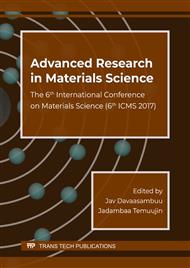[1]
L. Wang, X. Ma, R. Chen, et al. Ultraviolet nano-photodetector based on ZnS: Cl nanoribbon/Au Schottky junctions, J. Mater. Sci.: Mater. Electron. 26 (2015) 4290-4297.
DOI: 10.1007/s10854-015-2981-8
Google Scholar
[2]
Y. Chen, G. Jiang, S. Chen, et al. Mechanically exfoliated black phosphorus as a new saturable absorber for both Q-switching and mode-locking laser operation, Opt. Express. 23 (2015) 12823-12833.
DOI: 10.1364/oe.23.012823
Google Scholar
[3]
S. Cho, M. S. Fuhrer, Charge transport and inhomogeneity near the minimum conductivity point in graphene, Phys. Rev. B. 77 (2008) 081402.
DOI: 10.1103/physrevb.77.081402
Google Scholar
[4]
Z. Ling, R. Yang, J. Chai, et al. Large-scale two-dimensional MoS2 photodetectors by magnetron sputtering, Opt. Express, 23 (2015) 13580-13586.
DOI: 10.1364/oe.23.013580
Google Scholar
[5]
K. Roy, M. Padmanabhan, S. Goswami, et al. Graphene-MoS2 hybrid structures for multifunctional photoresponsive memory devices, Nat. Nanotechnol. 8 (2013) 826-830.
DOI: 10.1038/nnano.2013.206
Google Scholar
[6]
W. J. Yu, Y. Liu, H. Zhou, et al. Highly efficient gate-tunable photocurrent generation in vertical heterostructures of layered materials, Nat. Nanotechnol. 8 (2013) 952-958.
DOI: 10.1038/nnano.2013.219
Google Scholar
[7]
M. Buscema, D. J. Groenendijk, G. A. Steele, H.S. van der Zant, Castellanos-Gomez A. Photovoltaic effect in few-layer black phosphorus PN junctions defined by local electrostatic gating, Nat. Commun. 5 (2014) 4651.
DOI: 10.1038/ncomms5651
Google Scholar
[8]
Y. Deng, Z. Luo, et al. Black Phosphorus-Monolayer MoS2 van der Waals Heterojunction p-n Diode, ACS Nano, 8 (2014) 8292-8299.
DOI: 10.1021/nn5027388
Google Scholar
[9]
M. Engel, M. Steiner, P. Avouris, Black phosphorus photodetector for multispectral, high-resolution imaging, Nano Lett. 14 (2014) 6414-6417.
DOI: 10.1021/nl502928y
Google Scholar
[10]
S. Cui, H. Pu, S. A. Wells, et al. Ultrahigh sensitivity and layer-dependent sensing performance of phosphorene-based gas sensors, Nat. Commun. 6 (2015) 8632.
DOI: 10.1038/ncomms9632
Google Scholar
[11]
W. Zhang, C. P. Chuu, J. K. Huang, et al. Ultrahigh-gain photodetectors based on atomically thin graphene-MoS2 heterostructures, Sci. Rep. 4 (2014) 3826.
DOI: 10.1038/srep03826
Google Scholar
[12]
S. C. Dhanabalan, J. S. Ponraj, Z. Guo, et al. Emerging trends in phosphorene fabrication towards next generation devices, Adv. Sci. 4 (2017) 1600305.
DOI: 10.1002/advs.201600305
Google Scholar
[13]
N. Huo, S. Yang, Z. Wei, J. Li, Synthesis of WO3 nanostructures and their ultraviolet photoresponse properties, J. Mater. Chem. C. 1 (2013) 3999-4007.
DOI: 10.1039/c3tc30527a
Google Scholar
[14]
L. Li, Y. Yu, G. J. Ye, et al. Black phosphorus field-effect transistors, Nat. Nanotechnol. 9 (2014) 372-377.
Google Scholar
[15]
J. D. Wood, S. A. Wells, D. Jariwala, et al. Effective passivation of exfoliated black phosphorus transistors against ambient degradation, Nano Lett. 14 (2014) 6964-6970.
DOI: 10.1021/nl5032293
Google Scholar
[16]
J. S. Kim, P. J. Jeon, J. Lee, et al. Dual gate black phosphorus field effect transistors on glass for NOR logic and organic light emitting diode switching, Nano Lett. 15 (2015) 5778-5783.
DOI: 10.1021/acs.nanolett.5b01746
Google Scholar


